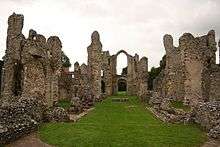Pulpitum
The pulpitum is a common feature in medieval cathedral and monastic church architecture in Europe. It is a massive screen, most often constructed of stone, or occasionally timber, that divides the choir (the area containing the choir stalls and high altar in a cathedral, collegiate or monastic church) from the nave and ambulatory (the parts of the church to which lay worshippers may have access).[1] Typically the pulpitum is lavishly carved and decorated, and those of York Minster and Canterbury Cathedral preserve complete medieval sets of statues of the Kings of England.

The word pulpitum is applied in ecclesiastical Latin both for this form of screen and also for a pulpit; the secular origin of the term being a theatrical stage, or speaker's dais.[2] It is thought that this form of screen originated in monastic practice, providing a raised stage from which members of a religious communities could address pilgrims attending to venerate the church's relics, while still maintaining their monastic seclusion from lay contact.

An internal stair within the thickness of the pulpitum gives access to a broad upper platform, which commonly supports the cathedral organ. The pulpitum is invariably pierced by a central passage, leading immediately into the choir stalls to the (ritual) east. Many pulpita, as those of Glasgow Cathedral, Exeter Cathedral and Southwell Minster, incorporated subsidiary altars either side of their central passages.
In the late medieval period, there was also a rood screen or rood beam placed one bay to the west of the pulpitum (i.e. further away from the high altar of the cathedral), and the main nave altar for the use of lay worshippers was set against its western face. This screen was pierced by lateral doors, left and right, for processional access to the nave, and for the use of pilgrims who would pass into the eastern arm of the church via the ambulatory to the feretory or shrine, commonly located behind the high altar. Most of these rood screens were demolished at the English Reformation, although the cathedrals of Peterborough and Canterbury retained their separate rood screens into the 18th century; and in the collegiate church of Ottery Saint Mary, both sets of screens remained until the early 19th century. At the former monastic churches of Saint Albans and Ewenny the rood screens survive, while the pulpita do not.
Several English cathedrals demolished their pulpita in the early 19th century, intending to open the view from the congregation to the high altar; but in most instances this was found to be unsatisfactory, and a much less massive chancel screen was erected in its place.
See also
References
- Morris, Richard (1979). Cathedrals and Abbeys of England and Wales. London: Dent. pp. 144. ISBN 0-460-04334-X.
- Friar, Stephen (1996). A Companion to the English Parish Church. Bramley Books. p. 369. ISBN 1-85833-738-0.